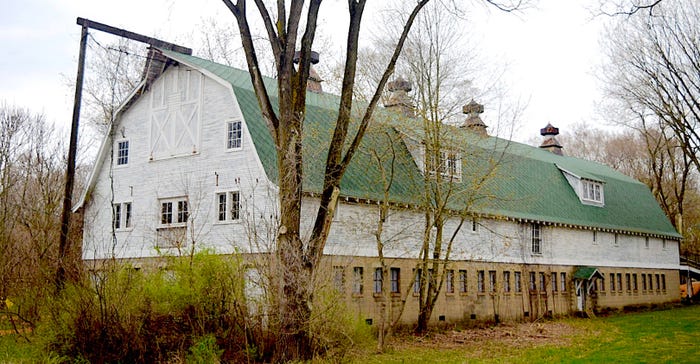April 27, 2020

Women often are credited with being the driving force behind saving heritage barns. In the case of one big barn in Benton Harbor, Mich., that is true three times over.
The story begins in 1903 when Benjamin Purnell, a broom maker and traveling preacher from Kentucky, and his wife, Mary, arrived in Benton Harbor to start the Israelite House of David commune on Territorial Road.
By 1916, more than a thousand people had joined, accepting Purnell’s rules: celibacy, vegetarianism, no military service, no tobacco, no alcohol and no haircuts. All earnings were shared. The commune grew rapidly and successfully, having a farm, resort, school, hotel, businesses and much more.
In the 1920s, Purnell was alleged to have had sex with girls in the commune. He evaded arrest for two years, but was caught in 1926 and convicted of fraud, but died of tuberculosis before sentencing.
Midwest's largest dairy barn
The scandal split the commune, and in 1930, Mary Purnell created Mary’s City of David, just across the road from the original community, and almost immediately built a 36-foot-by-141-foot dairy barn designed by William Wright. It was reported to be the largest dairy barn in the Midwest. Some documents refer to it as a Sears kit barn.
It was ultramodern, having stanchions for 41 cows, four calf pens and two 150-ton silos. A 5,000-gallon water tank built into a hill provided gravity-driven freshwater 24 hours a day. A cooling room with several tanks protected the milk.
Mary would be the first of the three women to have an association with the big barn. Next came Charity Sassman, one of the House of David’s faithful, who every day, wearing a long blue apron dress, managed the dairy operation.
In his book, "House of David," Chris Siriano writes, “They (Charity and her husband, George) worked from well before daylight until after sundown at the David Dairy Barn.”
“She was a tough old gal,” recalls Bill Clark of Kalamazoo, Mich., who has fond memories of playing in the barn when his parents visited Charity’s family. “Charity was a taskmaster down at the barn, but a kind heart at the house at day’s end.”
Bill’s sister Sue Gehrman of Battle Creek, Mich., recalls, “Charity was quite the character, a skinny little woman with a long braid that she wrapped up and pinned to her head. She talked with a Texas accent and tough as nails! We called her Barn Grandma.”
Mary Purnell died in 1953 and Charity, after her husband’s death, had help with the farm from her son Bill, who was born during her first marriage to Thomas Boyette.
Charity died in 1972 at age 95 after running the dairy for 59 years. As House of David members dwindled into the 1990s, the big barn stood empty with gaping holes in its roof, while Charity’s house on the hill was badly vandalized.
Saving the barn
Then, one day in 1999, while returning from her work as a commercial designer in Chicago to visit family in Wacousta, Mich., the third hardworking woman arrived in the life of the great big barn.
“I didn’t like taking the expressway with my two young children in the car, so I found Territorial Road a nice alternative. That is when I saw the barn,” Amy Hepler Briske recalls. “I stopped at a neighbor’s place and asked who owned it. They said, ‘House of David and they do not sell their property so forget about buying it!’
Just 29 and quite unfamiliar with the House of David story, Amy replied, “Maybe when David meets me, he will like me.”
Amy could not put the sad-looking barn out of her mind and learned that it was owned by a golf course. After months of negotiations, the barn, the house and 6 acres became hers, saving the barn from impending demolition.
Cash-poor but determination-rich, Amy’s first mission was to get a new roof on the barn to stop the damage and protect her treasure. Then, she rolled up her sleeves and started working, weekend after weekend to reclaim the house, barn and property.
In 2002, Amy met Kirby Briske. Kirby, also a Michigan native, is a master carpenter. The two combined skills to tackle everything from repairs to remodeling and codes to contracts as their vision for making the barn into a wedding venue took shape. Her eyes sparkle as she says, “We were the first couple to marry in the barn!”
Amy said she was doing some painting in 2003 when she noticed the name “Loyd Dallager” written on a rafter, with the date 1930.
“I called the House of David to ask if this person still existed after all these years, wondering why his name was written in the barn,” Amy says. “Dallager himself answered the phone! He said he had been an electrician and wanted to leave his name as part of the legacy of the barn. The very day I talked to him was his 90th birthday.”
The once-abandoned House of David barn, now called “Blue Dress Barn,” has twice earned Best Wedding Venue honors from Brides magazine.
Amy does not hesitate to say, “I feel Charity’s spirit here all the time.” And now that Amy and Kirby’s daughter, Georgia Rosemary, who occupies the bedroom that was once Charity’s, dreams of one day being the caretaker of the Blue Dress Barn, “three” may become “four courageous women.” Charity, in her long blue apron dress, would be proud.
Arnett is co-founder of the Barn Believers Community Project Fund with the Battle Creek Community Foundation and author of American Barns. Email her at [email protected]. She writes from Battle Creek, Mich.
About the Author(s)
You May Also Like




